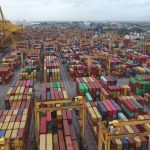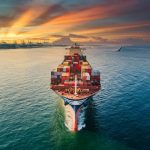The International Maritime Organization’s (IMO) 2023 Greenhouse Gas (GHG) Strategy has three interlinked ambitions: a reduction in carbon intensity of international shipping by at least 40% by 2030, compared to 2008; the uptake of zero or near-zero GHG emission technologies, fuels, and/or energy sources representing at least 5% of the energy used by 2030; and GHG emissions from international shipping to reach net zero by or around 2050.1
Decarbonization of all vessels in the worldwide shipping sector is critical for reaching the IMO ambitions and will be achieved by using alternative fuels and reducing fuel consumption. Methanol, methane, and biofuels as well as ammonia are promising fuels for zero-emissions ocean transport.
Implementation of ammonia as a marine fuel is expected to be technologically feasible by 2025-2026, but this implementation will create new challenges for the maritime community. In particular, ammonia’s toxic nature requires the industry to develop new approaches to safety. Fortunately, some sectors of the industry already have extensive experience in handling and transporting ammonia as cargo at sea, with approximately 18-20 million tonnes of ammonia traded annually through about 120 global ports.2,3 The safe use of ammonia as a fuel will draw heavily on this experience.
The Mærsk Mc-Kinney Møller Center for Zero Carbon Shipping (MMMCZCS) has been studying ammonia safety since 2021. A 2023 publication jointly produced by the MMMCZCS and Lloyd’s Register presents a quantitative risk assessment analysis and preliminary account of the human factor considerations that will be impacted by the transition to ammonia fuel use.4
In October 2023, the MMMCZCS organized a roundtable dedicated to ammonia safety with multiple key stakeholders from the shipping and ammonia industries. This meeting highlighted the need to assess the risk perception regarding ammonia as a marine fuel across onboard and ashore maritime communities, which could have a significant impact on ammonia’s uptake as a marine fuel.
The MMMCZCS has therefore undertaken a survey on ammonia risk perception and acceptance with the goal of hearing the direct voice of the maritime community. Our objective is to help the industry lift the barriers to implementation of ammonia as a marine fuel in a collaborative way and facilitate a safe transition to alternative fuels.
The survey reached over 2,000 respondents across the maritime community covering a range of different ages, positions, vessel segments, and level of experience with gaseous fuels or ammonia as cargo. Over half (58.6%) of the total respondents agreed that they would be willing to sail on or work with ammonia-fueled vessels, while 24% were unsure and 12% reported that they would not be willing. More specifically, 59% of seafarers and 57% of ashore personnel who responded to the survey agreed that they would be willing to work with ammonia. While more than half of the respondents were willing to sail on or work with ammonia-fueled vessels, these respondents nevertheless raised some specific concerns, especially regarding training and safety.
Many of the survey responses emphasized the desire for more knowledge and training about ammonia. When asked about what knowledge they needed regarding ammonia as marine fuel, respondents highlighted many topics relating to safety, such ammonia’s impact on humans and the environment, firefighting and other emergency response procedures, and ammonia characteristics. Respondents also expressed a desire for comprehensive training – including on safety-focused topics such leakage management, emergency response, and risk analysis, but also on new engine procedures and maintenance, regulation, and gas as fuel.
Continuing on the theme of safety, the survey sheds light on the primary safety concerns of both seafarers and ashore personnel. The respondents’ basic perception of the characteristics (e.g., toxicity) and safe handling of ammonia seems to be generally accurate and reflects a good understanding of the possible risks involved. However, the survey showed a lack of knowledge regarding some technical aspects of ammonia handling and operations. Further study, communication, and training on these topics are, therefore, important. The survey responses also highlighted the importance of safer technology and design to support ammonia’s introduction as a marine fuel.
Another area of concern for survey respondents was the effectiveness and readiness of regulations – that is, whether regulations would be ready in time to appropriately protect seafarers from ammonia-related safety risks. Respondents additionally called for strict safety standards surrounding the design of the fuel systems.
Implementation of ammonia as a marine fuel will also require additional investments, such as costs associated with upskilling and training of seafarers. In the survey comments, some seafarers expressed their desire for monetary compensation due to the potential risks involved with the operation of ammonia as a marine fuel and the added complexity to their job.
Overall, the survey results suggest that the majority of the maritime community is willing to sail on and work with ammonia-fueled vessels. With that said, several barriers remain that will have to be addressed, including comprehensive training and safer ship and system designs. Some of these topics will be addressed in current or future MMMCZCS projects, including a project linked to future revisions of the STCW Tables relating to the International Code of Safety for Ships Using Gases or Other Low-flashpoint Fuels (IGF Code) in the International Convention on Standards of Training, Certification and Watchkeeping for Seafarers (STCW Code).5
In publishing this survey report, we aim to share the opinions, concerns, and suggested ways forward raised by the community who will be most directly impacted by the use of ammonia as a marine fuel. The knowledge shared in this report can help the industry to address the concerns and misperceptions raised by first-in-line operators. In addition, the survey findings can be used to shape future training content and address upcoming ship and fuel systems designs, as well as guidelines for safe bunkering and in-port handling of ammonia.
Source: Mærsk Mc-Kinney Møller Center for Zero Carbon Shipping (MMMCZCS)






